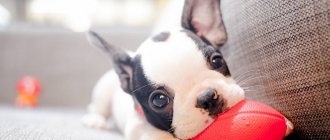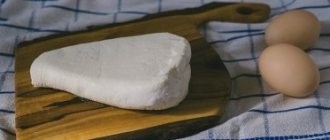How to tell when it's time to clean your dog's ears
Due to the small stature of dogs, their ears become dirty with dust, splashes from puddles, grass, and insects. It is extremely important to keep these organs clean, but hygiene cannot be done every day.
Sebum and wax are essential to protect the delicate epidermis inside the ears. They protect the organ from sudden temperature fluctuations, mosquito bites and bugs. By removing the beneficial layer, you can harm your pet and cause microtraumas, inflammatory processes, fungi and bacterial diseases.
Moderation is important in everything. In lop-eared dogs, dirt accumulates faster in the ears due to the lack of adequate air circulation. To determine whether it is time to remove wax, you need to lift the skin and look into the sink. For breeds with erect ears, it is sufficient to carry out an examination once every 2 weeks.
A simple test will help you accurately determine the need for a hygiene procedure. A moistened cotton swab or swab should be rubbed along the inside of the dog's hearing aid. If the instrument is clean, you can postpone the event. If a small yellow or dirty coating forms, you must wait a few days. Identification of large lumps of sulfur requires their immediate removal.
How to Determine Cleaning Frequency
Depending on the breed of the dog, the frequency of procedures is regulated. So, some pets need to be cleaned literally every day or at least every other day. These are long-haired breeds with floppy ears. The ventilation of the ears of these dogs is worse than that of short-haired breeds with erect ears. You should also take into account the age of the animal and its lifestyle.
In dogs with erect ears
How often to clean your dog's ears depends on the breed of the animal. Some popular breeds are advised to have their ears cleaned with additional guidelines.
Ear examinations should be weekly for all breeds, but cleaning is approximately:
- once a week for lop-eared dogs;
- once every two weeks for breeds with erect ears.
The ears of some short-haired breeds require special care. These include the German Shepherd - this breed is especially valued for its good hearing. Cleaning is a mandatory procedure performed weekly to maintain the dog’s working qualities. The same recommendations apply to other service and guard breeds.
Dogs with long ears
Dust, dirt, and earwax accumulate more quickly on the surface of long ears. And since long ears are less ventilated, this leads to debate and the development of pathogenic microorganisms and fungus. Therefore, fold-eared breeds need to clean their ears more often than pets with erect ears.
Be sure to be wary if dirt regularly accumulates in the ear or if your pet behaves restlessly, scratches its ears, or shakes its head. These are the first symptoms of diseases. Take your dog to a specialist to rule out health problems. If you regularly groom your dog, but dirt is constantly accumulating in the ears, it is better to consult a veterinarian to avoid causing the problem.
Some breeds with erect ears also require painstaking care: this applies to those animals that have thick and long hair growing in their shells. It prevents ventilation and creates favorable conditions for the development of harmful microorganisms. The ears of such pets are examined at least once a week, and for hygiene purposes the hairs in the ear canals are shortened.
Importance of the procedure
Cleaning a dog’s ear is a disease prevention and a way to promptly detect disorders that require a veterinary examination and proper treatment. The appearance of an unpleasant odor is a signal of problems. It could be a mite, yeast-like fungi, or bacteria.
Expert opinion
Anna Abramenko
An avid dog lover. Experience in veterinary medicine since 2009.
Ask a Question
Cleaning your ears on time is important. The question concerns not only the aesthetic side, but also health. When a large amount of sulfur secretions accumulates, a dog may develop otitis media. Parasites are often associated with inflammation.
When should your dog's ears be cleaned?
Experts recommend regularly examining your pet's ears to avoid any unpleasant surprises in the form of inflammation, otodectosis (ear mites) or a fungal infection. It is clear that prevention is easier and cheaper than treatment.
It is advisable to examine lop-eared and long-haired dogs every other day, straight-eared and short-haired dogs - 1-2 times a week.
Fold-eared breeds often require ear inspection. Photo: Nik Stanbridge
Some doctors talk about daily inspection of “problematic” shells and monitoring the growth of hair inside the ear. Lost and dead hairs can lead to blockage of the ear canal. This can be easily prevented by removing them with pinching movements of your fingers - the dog will be ticklish, but not painful.
It is important to pay attention to changes in the behavior of your four-legged friend. If the dog whines, growls when trying to touch the ears, shakes its head, tilts it to the side, or scratches behind the ears with its paws, an unscheduled examination is needed.
If during inspection you find:
- skin redness
- bad smell
- brown discharge
- scratching behind the ears,
then you have a direct route to the vet.
Your doctor will determine the cause of your dog's ear problems.
The doctor will examine the pet, make an accurate diagnosis and prescribe a course of treatment in accordance with the disease, weight, and condition of the animal. Self-medication or ignoring the problem is fraught with the development of inflammation, including hearing loss or death.
Ways to clean your ears
There are different techniques. The scheme is almost always the same, the only difference is in the means used.
Professional drugs
The pet store offers a wide range of lotions and gels for gentle care of dogs' ears. Each product comes with instructions, but the procedure is roughly the same.
Cleaning principle:
- pull back the ear;
- pour 2-3 drops of product into the sink;
- hold the dog so that it does not shake its head;
- perform a light massage for better distribution of fluid along the walls;
- After 2 minutes, wipe the inside of the ear with a cotton pad or swab treated with the same cleaning agent.
It is forbidden to immerse hard devices deep into the dog's ear. This risks damaging the eardrum and causing further problems.
Folk remedies
Chamomile infusion, string, mint, tea leaves, etc. are used. The instructions for use have one distinctive feature - the liquid is prohibited from pouring into the ear.
How to clean:
- Cool the prepared infusion to room temperature;
- Wipe the sink and ear canal with a dry cotton swab or disk;
- moisten another clean instrument in the prepared solution;
- treat the inside and hollows of the ear;
- wipe the sink dry.
How to clean a puppy's ears
You should clean the ears of a puppy or an adult dog only when necessary; many veterinarians do not recommend doing this procedure over and over again. There are certain indications for which cleaning is considered mandatory.
Representatives with short fur only need to have their ears cleaned on rare occasions. But dogs with long hair and floppy ears should be cleaned much more often.
If you are a caring and attentive owner, then be sure to take your pet to the veterinarian for an examination every month. A specialist will be able to promptly detect wounds, damage, diseases, neoplasms, parasites, and insects.
Doctors do not recommend removing wax unless there is a lot of it. This is considered normal and nothing bad will happen to it. But in dogs with long hair, clumps of fallen hairs can often accumulate in their ears, which must be removed.
If you don’t want your dog to have problems with his ears, then you should clean them correctly. First of all, you should pay attention to the following factors:
- Pay attention to the color of the inner area of the hearing organ; if the ear is pink, then it does not need to be cleansed. This sign indicates that the ear canal is clean;
- If there is sulfur with a dark tint inside, it can be cleaned with a damp cloth;
- Lost hair should be removed with tweezers, otherwise the hairs will get into the ear canal. In the summer, the lumps will become an excellent place for insects to accumulate, which can cause severe inconvenience to the dog;
- Pay attention to your pet's behavior; if he constantly scratches his ears, strongly jerks and shakes his head when touched, this may be a symptom of the presence of a disease. In this case, it is better to show the animal to a veterinarian;
- If the dog often shakes its head, especially after sleep, then you should pour a drop of special lotion into the auricle and massage it. If these manipulations do not bring relief, it is better to consult a specialist.
To make sure whether you need to clean your ears or whether you should abandon this procedure, it is recommended to conduct a simple test at home. A cotton swab needs to be slightly moistened with warm water. Afterwards, she needs to hold it near the ear canal and look at the result.
If the fleece is light gray or slightly yellow, then cleaning may not be necessary. But if there are pieces of wax and a lot of dirt on the cotton swab, then it is better to resort to hygienic treatment of the ears.
Frequency
The frequency of ear cleaning in different types of dogs depends on a large number of factors, among which a special place is given to the age of the pet and the structure of the hearing aid. Healthy puppies and young individuals undergo hygiene at intervals of 2-3 months. But this is an average value. To determine the need for the procedure, the following nuances must be taken into account:
- presence of heavy contamination;
- restless behavior, shaking the head, scratching the ears with paws;
- formation of scratches and wounds on the inner surface;
- accumulation of black plaque with a specific odor.
In these cases, it is recommended to carry out hygiene with chlorhexidine or miramistin. If after a short period of time wax or plaque has formed again, it is recommended to show the dog to a veterinarian.
Preparation for the procedure and selection of funds
As stated above, cleaning dogs’ ears should be carried out only when indicated; it does not need to be done every day, otherwise hearing problems may arise. If this procedure is done regularly, the owner will form a kind of schedule, he will know when the pet’s ears are especially dirty, and will be able to quickly fix the problem.
It is worth noting! If your tailed friend’s ears become dirty quickly enough, all this is accompanied by an unpleasant odor and severe itching, then you should immediately contact a veterinarian.
If the dog is undergoing treatment, then everything should be done only after preliminary consultation with a specialist. All medications, their regimen of use and dosage must be prescribed by a veterinarian.
Ear cleansers
To clean the ears and ear canals, veterinarians recommend using the following products:
- Special lotions. They dissolve accumulations of dirt and earwax. With their help, you can clean the ears of a German Shepherd puppy and representatives of other elite breeds. When removing, massage using a dry cloth;
- A solution of chlorhexidine with an aqueous base. This remedy is an effective and affordable antiseptic;
- Saline solution. It can be pharmacy or homemade (1 liter of boiled water and 1 teaspoon of salt). The product has an antiseptic effect;
- A weak solution of sea salt has a good effect. It dries out the skin;
- Wipes that are designed for hygiene of the auditory organs of dogs have a good effect. They can be purchased at a veterinary pharmacy. They contain a special component that causes the dissolution of mud deposits. The wipes do not cause irritation or redness;
- Special powder, it is suitable for dogs with long ears. It dries the inner surface of the ear, improves the ventilation process, and reduces the accumulation of wet dirt. For hygiene procedures, you can use the following brands of powder: Espree EAR POWDER, Hygienic Powder for Ears 8in1 Excel 3 in 1 Ear Powder (USA);
- Special oils. These products are recommended for use when there is a large accumulation of dirt that requires softening;
- Cotton pads. They are much safer than cotton swabs; they do not damage the ear, do not scratch, and with their help you can completely clean out all the dirt and accumulations of wax.
What products are best not to use?
The following products are not recommended for cleaning a dog's ears:
- Alcohol or strong saline solution. These products provoke severe drying and irritation of the skin;
- Vinegar, hydrogen peroxide. If the product gets deep into the ear, a burn may occur;
- Well-known drops "Bars" and other similar products that are not intended for preventive cleansing of the ears. It is advisable, before using the medicine, to carefully study the instructions and first consult with your doctor;
- Paper napkins. When moistened, they fall apart, small pieces can get deep into the ear;
- The oil should be used only strictly according to indications. It can cause hairs to stick together and block the ear canal;
- Few, baby lotions. They contain components that are harmful to dogs and can cause allergic reactions.
You should not use gauze to treat dogs' ears; threads from it can penetrate deep into the ear canal. If you have never had to clean your ears before, it is better not to use cotton swabs for this; in inept hands they can injure your ears and push dirt and lumps further.
Exercise caution
The procedure for treating and cleaning dogs' ears must be carried out correctly. You should carefully prepare for it. When carrying out this procedure, important precautions must be taken.
Below is a list of what not to do:
- When cleaning, you should never cause your dog pain;
- Do not penetrate too deeply into the auricle;
- You should not clean your ears, wipe and rub them every day until they become shiny. Veterinarians say that sulfur must be present on the surface of the auricle and ear canal; it protects against dust, dirt, and temperature changes. If this substance is not present, then bacteria will quickly penetrate inside, and in the future they will cause dangerous diseases;
- You should not clean the ears against the will of the dog, holding it by force. The animal will experience severe stress, negative emotions, hostility, all this will be thoroughly entrenched in the subconscious and will continue to get worse. In addition, resistance causes microtraumas and damage in which bacteria and parasites can multiply;
- Do not pour alcohol or hydrogen peroxide into the ear. The product can cause severe drying and burns may occur;
- Do not use expired medications or products that have been stored incorrectly.
Care products
The following options are suitable for carrying out hygiene procedures in the comfort of home:
- Wet wipes for dogs. Thanks to their softening impregnation, they effectively dissolve dirt and wax, but do not irritate delicate skin.
- Lotion. The most popular and sought-after cleaning product, capable of collecting all the secretions and removing them with a gentle massage or simple shaking of the head.
Expert opinion
Anna Abramenko
An avid dog lover. Experience in veterinary medicine since 2009.
Ask a Question
Lotions are not recommended for frequent use. Optimally – once a month. This medication is also contraindicated in dogs with perforated eardrums.
- Powder. A convenient option for hygiene of long ears. It dries out wax and absorbs moisture, which helps clean your dog’s hearing aid faster and more painlessly. Eliminates foul odor and kills bacteria.
- Cleaning drops. This product has several useful properties - disinfectant, medicinal, healing, antipruritic. They are used in the same way as lotions.
- Cotton buds. Replacement for gauze and tampons. They are impregnated with a solution, helping to better absorb moisture and remove dirt from the walls of the ears. It is recommended that the dog's ears be treated carefully with these devices to avoid injury.
If you don’t have professional products at home, you can clean your dog’s ears using the following liquids:
- Sea salt solution. Dilute 1 tsp in a glass of warm boiled water. salt, moisten the disc in this liquid and use it to remove deposits in the ear canal.
- Chlorhexidine. Pour a small amount of 0.5% antiseptic into each ear of the dog using a pipette; after a light massage, she should shake her head.
- Herbal infusions. Chamomile flowers and calendula have a healing, healing effect. They should not be put in the ears, but you can rinse them with a moistened swab or cotton swab.
- Green tea. Prepare a fresh drink, soak gauze or other device in it and use it to remove sulfur from inside the sink.
If a specific odor and itching appears from the ears, rinsing with hydrogen peroxide is recommended. Pour 5 drops of the 3% solution into each pass. For convenience, it is advisable to use a syringe without a needle for instillation. After the infusions, the dog will shake his head and everything will come out. Then the moisture is soaked with a dry towel.
How?
- A cotton swab is the most common option. The stick is soaked in a special lotion; it can also be used to rub powder and rub in drops. But for beginners, this is not the best option, because a stick can easily damage the animal’s delicate ear. Important: do not be afraid to rupture the eardrum: a dog’s ear is designed in such a way that it is impossible to reach it.
- A cotton ball, dry or wet, works great for gentle ear care. It should be placed in the ear and gently rolled, cleaning all corners. The most important thing is to remember that the ball will still need to be taken out.
- A cotton pad is another alternative to a ball; there is not much difference between them. They can be used to gently remove dirt from inside the ear. But it will be difficult to manipulate a cotton pad on an irritable animal, because it is a slow process.
- Sanitary wipes for dog ears. This miracle remedy can be purchased at any veterinary pharmacy. They are already impregnated with a special composition that will dissolve dirt and sulfur. The wipes are great for emergency cleaning of the ears, for example, before a show, to give your pet a thorough cleaning. You can use them regularly, but it is much more expensive than a cotton ball.
What is the best way to clean the ears of a particular dog is difficult to say without trying. Most likely, it will be easier with a cotton ball or napkin, but it all depends on the character of the pet and the condition of the ears. Sometimes you will need the entire arsenal.
What not to use
The following remedies can leave a burn, injury, and irritate the thin epidermis in a dog’s ear:
- ethyl, food and boric alcohol;
- gel, shampoo, soap, etc.;
- vinegar essence;
- oil extracts.
Expert opinion
Anna Abramenko
An avid dog lover. Experience in veterinary medicine since 2009.
Ask a Question
The dog's ears should be carefully inspected and cleaned carefully. This is a sensitive organ that reacts with inflammation to various violations of hygiene.
Disinfectants and cleaning tools
Currently, entire series are being produced designed for comprehensive care for four-legged pets.
If necessary, it is quite possible to use home remedies based on medicinal herbs or standard pharmaceutical preparations.
So how can you clean your dog's ears? To do this, it is recommended to purchase the products presented:
- hygienic special wet wipes impregnated with medicinal compounds that do not cause irritation, but effectively dissolve accumulations of dirt and sulfur;
- cotton swabs soaked in special lotions for cleaning dogs' ears;
- hygienic liquids for cleaning dogs' ears , capable of collecting dirt and dissolving natural secretions in the form of sulfur;
- special powders used for long-eared dogs and ensuring the removal of excess moisture, as well as improving ear ventilation.
If necessary, regular pharmacy gauze, hydrogen peroxide, baby lotions, herbal infusions and cotton pads, and drops for cleaning dog ears can be used.
Important! The use of commonly available home remedies will require the dog owner to be especially careful and strictly adhere to ear cleaning techniques.
Rules for cleaning ears
The procedure is carried out extremely carefully. It is important not to cause pain or discomfort to the dog, so that in the future it behaves calmly and trustingly waits for the end of the cleaning.
Step-by-step instruction:
- Wash the animal so that it calms down and relaxes.
- While stroking and praising, lay the dog on its side.
- Carefully lift your ear up.
- Inspect all depressions. If there is dried dirt, it should be moistened with the selected softening agent.
- After applying the drops, lotion or other drug, massage. Gentle rubbing movements will dissolve the wax and remove it from your dog's ear canal.
- Remove the residue with a cotton swab or swab previously soaked in the product.
How to clean at home
Labradors' ears are most often clean, and plaque is extremely rare. Soak a cotton swab in the oil solution and gently clean your dog's ears. Do not push the cotton very deep - it may get stuck or damage the inside of the ear.
Important! It is better to clean those places that are clearly visible. Now there are various drops that allow you to lift dirt from the ear to its upper part, but it is not recommended to use such products often.
The most important thing is just keep an eye on your pet’s ears and assess the degree of contamination.
A Labrador's ears do not need too much attention - look into them when brushing the coat and after the dog has gotten very dirty in the mud.
Step-by-step instructions on how to properly clean your dog's ears
Despite its apparent simplicity, such a hygienic event as cleaning a dog’s ears requires compliance with some important rules :
- At the first, preparatory stage, you need to prepare all the tools and disinfectants for cleaning dogs’ ears, and also secure the animal by laying it on its side and turning the outer ear up. It is most convenient to clean the ears immediately after bathing your pet ;
- Before cleaning, a visual inspection of the auricle must be performed . To calm your dog, you need to talk to it in a quiet, but confident and calm voice. During the inspection process, a decision is made on the use of certain hygiene products;
- in the absence of signs of inflammation, but the accumulation of a significant amount of dirt and earwax, they are dissolved with lotion, which is applied to a cotton pad or gauze pad. You can use special wet wipes or spray ;
- The outer ear is warmed up with light massaging movements, during which wax and dirt are effectively removed. At the final stage, the remnants of the hygiene product are removed with a dry cotton pad or gauze.
Important! It is difficult for large breeds of dogs to immediately remove dirt with a regular cotton pad, so in this case, use a gauze pad soaked in a chamomile solution or lotion and wrapped around the index finger.









